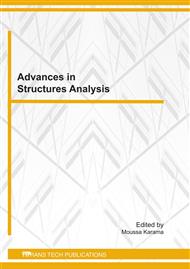p.25
p.33
p.43
p.55
p.65
p.71
p.79
p.85
p.95
The Non Destructive Testing Methods Applied to Detect Cracks in the Hot Section of a Turbojet
Abstract:
All aircraft whatever they are; are regularly audited. These controls are mainly visual and external; other controls such as "major inspection" or "general revisions” are more extensive and require the dismantling of certain parts of the aircraft. Some parts of the aircraft remain inaccessible and are therefore more difficult to inspect (compressor, combustion chamber, and turbine). The means of detection must ensure controls either during initial construction, or at the time of exploitation of all the parts. The Non destructive testing (NDT) gathers the most widespread methods for detecting defects of a part or review the integrity of a structure. The aim of this work is to present the different (NDT) techniques and to explore their limits, taking into account the difficulties presented at the level of the hot part of a turbojet, in order to propose one or more effective means, non subjective and less expensive for the detection and the control of cracks in the hot section of a turbojet. To achieve our goal, we followed the following steps: - Acquire technical, scientific and practical basis of magnetic fields, electrical and electromagnetic, related to industrial applications primarily to electromagnetic NDT techniques. - Apply a scientific approach integrating fundamental knowledge of synthetic and pragmatic manner so as to control the implementation of NDT techniques to establish a synthesis in order to comparing between the use of different methods. - To review recent developments concerning the standard techniques and their foreseeable development: eddy current, ultrasonic guided waves ..., and the possibility of the implication of new techniques.
Info:
Periodical:
Pages:
79-83
Citation:
Online since:
June 2011
Authors:
Keywords:
Price:
Сopyright:
© 2011 Trans Tech Publications Ltd. All Rights Reserved
Share:
Citation:


